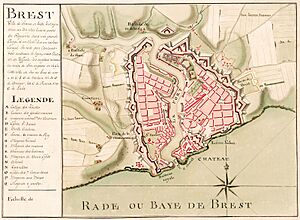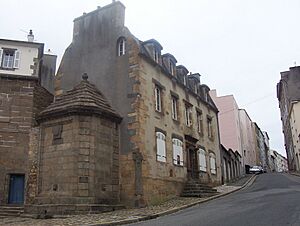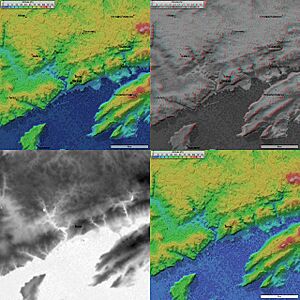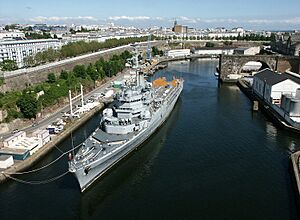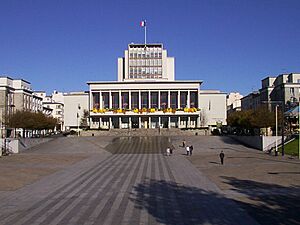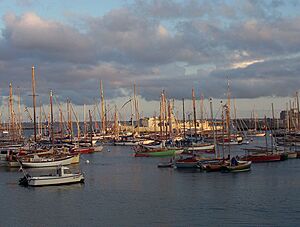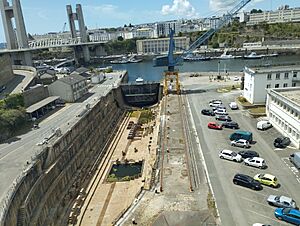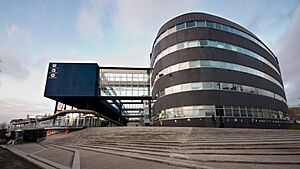Brest, France facts for kids
Quick facts for kids
Brest
|
|||
|---|---|---|---|
|
Subprefecture and commune
|
|||
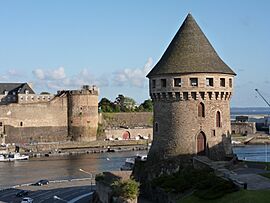
A view of the Tour Tanguy with the Château de Brest in the background
|
|||
|
|||
| Country | France | ||
| Region | Brittany | ||
| Department | Finistère | ||
| Arrondissement | Brest | ||
| Canton | Brest-1, 2, 3, 4 and 5 | ||
| Intercommunality | Brest Métropole | ||
| Area
1
|
49.51 km2 (19.12 sq mi) | ||
| Population
(2021)
|
139,619 | ||
| • Density | 2,820.02/km2 (7,303.8/sq mi) | ||
| Demonym(s) | Brestois (masculine) Brestoise (feminine) |
||
| Time zone | UTC+01:00 (CET) | ||
| • Summer (DST) | UTC+02:00 (CEST) | ||
| INSEE/Postal code |
29019 /29200
|
||
| Elevation | 0–103 m (0–338 ft) (avg. 34 m or 112 ft) |
||
| 1 French Land Register data, which excludes lakes, ponds, glaciers > 1 km2 (0.386 sq mi or 247 acres) and river estuaries. | |||
Brest is a lively port city in Brittany, France. It's located on a sheltered bay near the western edge of metropolitan France. Brest is a very important harbour and the second largest military port in France, after Toulon.
With about 139,000 people living there in 2020, Brest is the biggest city in Western Brittany. It's also the 25th most populated city in France. Even though it's the largest city in its area, the main administrative office for the department is in a smaller town called Quimper.
For a long time, Brest grew because of its naval shipyard. The city was badly damaged during World War II but was rebuilt afterwards. Today, Brest is a big university city with many students. It also has important research centers, especially for ocean studies. Since the 17th century, Brest's history has been closely linked to the sea. Every four years, the city hosts a huge international festival of the sea, where old ships from all over the world gather.
Contents
History of Brest
The name "Brest" might come from an old Celtic word meaning "hill." We don't know much about Brest before the year 1240. Around that time, it was given to John I, Duke of Brittany.
In 1342, Brest came under English control and stayed that way until 1397. This was important for the English because it helped them connect with their lands in Gascony. People used to say, "He is not the Duke of Brittany who is not the Lord of Brest," showing how important Brest was. In 1491, Brest became part of the French kingdom.
Cardinal Richelieu was the first to see how useful Brest's location was as a seaport. In 1631, he built a harbour with wooden docks. This quickly became a base for the French Navy. Later, Jean-Baptiste Colbert improved the harbour even more, using stone for the docks. Strong forts were built by Vauban between 1680 and 1688. These forts and the city's naval importance continued to grow.
In 1694, an English fleet tried to attack Brest but was defeated.

During World War I in 1917, Brest was a key port for American troops arriving in Europe. Thousands of soldiers passed through the port on their way to the front lines. The United States Navy also had a seaplane base here.
In World War II, the Germans used Brest as a large U-boat (submarine) base. It was also a place for German warships to get repairs. Because of its importance to the Germans, the city was heavily bombed by the Allies in 1944. Almost the entire city center was destroyed during the Battle for Brest. After the war, the city was rebuilt using a lot of granite and concrete. The French naval base in Brest is still very important today.
Since 1972, the French Navy has had a base for its nuclear submarines at Île Longue in the Brest roadstead. This base is still very important for France's defense.
Brest's Coat of Arms
The coat of arms of Brest is split into two parts. On the left, you can see the three golden fleurs-de-lis symbols of the old kingdom of France. On the right, there are black ermine spots, which are symbols of the Duchy of Brittany. These symbols were first used by the city council in 1683.
Places to See in Brest
Some famous sights in Brest include the Pont de Recouvrance, which is a huge drawbridge 64 meters (210 feet) high. The military shipyard and the Rue de Siam (Siam Street) are also interesting. The castle and the Tanguy tower are the oldest buildings in Brest.
The Musée de la Tour Tanguy is inside the Tanguy tower. It has cool dioramas that show what Brest looked like just before World War II. The Musée national de la Marine de Brest is in the old castle. It shows off Brest's long history with the sea.
Brest also has an amazing botanical garden called the Conservatoire botanique national de Brest. It specializes in saving endangered species of plants.
Because of the heavy bombing during World War II, Brest doesn't have many old buildings left, except for the castle and the Tanguy tower. The city was quickly rebuilt in the 1950s. In the Recouvrance area, on the west side of town, you can still find an old street from the 17th century called Saint-Malo Street.
Just a few kilometers outside the city, you can find beautiful landscapes. There are sandy beaches, cool grottos (small caves), and tall granite cliffs. People enjoy sunbathing, windsurfing, yachting, and fishing in the area. Brest was also a very important port for building warships during the Napoleonic wars. The naval port is carved into the rock and stretches along both sides of the Penfeld river.
Geography
Brest is located in a dramatic landscape near the entrance of the natural rade de Brest (Brest roadstead), at the western end of Brittany.
The city sits north of a beautiful bay that is almost completely surrounded by land. It is built on the slopes of two hills, with the Penfeld river flowing between them. The part of the city on the left side of the river is called Brest, and the part on the right is known as Recouvrance. There are also many neighborhoods to the east. Some of the hillsides are so steep that you have to use stairs to go from the lower parts to the upper parts of the city.
Climate
Brest has an oceanic climate, which means it's influenced by the sea. This gives Brest cool summers compared to other parts of France. Rain is common throughout the year, but it rarely snows because winter temperatures usually stay above freezing.
The hottest temperature ever recorded in Brest was 39.3 degrees Celsius (102.7 degrees Fahrenheit) on July 18, 2022.
Population
In 1945, Brest grew by adding three nearby towns. The population numbers before 1945 in the table and graph below are for the smaller area of Brest before these changes.
| Historical population | |||||||||||||||||||||||||||||||||||||||||||||||||||||||||||||||||||||||||||||||||||||||||||||||||||||||||||||||||||
|---|---|---|---|---|---|---|---|---|---|---|---|---|---|---|---|---|---|---|---|---|---|---|---|---|---|---|---|---|---|---|---|---|---|---|---|---|---|---|---|---|---|---|---|---|---|---|---|---|---|---|---|---|---|---|---|---|---|---|---|---|---|---|---|---|---|---|---|---|---|---|---|---|---|---|---|---|---|---|---|---|---|---|---|---|---|---|---|---|---|---|---|---|---|---|---|---|---|---|---|---|---|---|---|---|---|---|---|---|---|---|---|---|---|---|---|
|
|
||||||||||||||||||||||||||||||||||||||||||||||||||||||||||||||||||||||||||||||||||||||||||||||||||||||||||||||||||
| Source: EHESS and INSEE (1968-2020) | |||||||||||||||||||||||||||||||||||||||||||||||||||||||||||||||||||||||||||||||||||||||||||||||||||||||||||||||||||
Transportation
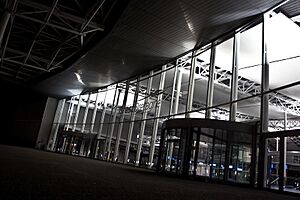
Brest has a railway station, Gare de Brest, which connects to Rennes and Paris. You can also take trains to other places in Brittany. High-speed TGV trains can get you to Paris in about three hours and forty minutes.
A new tram line with 28 stops opened in June 2012. It runs for 14.3 kilometers (8.9 miles) across the city.
Brest Bretagne Airport is an international airport with flights to Paris, London, Nice, Lyon, and Dublin. It's the busiest airport in Brittany, serving over 900,000 passengers in 2010. A new terminal opened in 2007, which can handle up to 1.8 million passengers each year.
The harbour of Brest is mainly used for large amounts of goods like oil and freight containers. The port can handle the biggest modern ships. There's also a cruise ship port near the city center.
Economy
Because of its location, Brest is seen as the first French port that ships from the Americas can reach. Shipping is a big business here. Brest is the ninth largest commercial harbour in France, and it's also important for ship repairs and maintenance. The protected location of Brest's harbour means it's perfect for all kinds of ships, from small boats to huge aircraft carriers. For example, the French aircraft carrier French aircraft carrier Charles de Gaulle was built in Brest.
Even though Brest is known as an industrial city, most of its economy (75%) comes from the service sector. This means jobs like banking, healthcare, and education are very important and are growing. Brest is also a major center for research, especially in ocean sciences. About 60% of France's research in sea-related fields happens in Brest.
Administration
Mayors of Brest
- Since 2001: François Cuillandre
- 1989–2001: Pierre Maille
Breton Language
The Breton language is not commonly spoken in Brest itself. Before the French Revolution in 1789, Brest was the only French-speaking city in western Brittany, even though the countryside around it spoke Breton. Like other minority languages in France, Breton does not have an official language status.
However, the city is working to bring Breton back. In 2006, the city started a plan to support the language. In 2008, nearly 2% of primary school children attended Diwan schools, which teach in both French and Breton. Breton is also taught in some schools and universities.
The Sked association helps organize all the Breton cultural activities in the city.
Culture
Brest hosts several events to celebrate its long history with the sea. The biggest event happens every four years, when the city organizes a huge meeting of tall ships. This event is called "Les Tonnerres de Brest." The last one was in 2016, and the next one is planned for 2022.
Brest also has an annual "Brest European Short Film Festival" where short movies are shown. The city was also the setting for the 1982 movie Querelle, which was based on a novel called Querelle de Brest.
Food in Brest
The most famous local food in Brittany is the Breton crêpe. You'll find many crêpe restaurants, called crêperies, in Brest. People often enjoy Breton apple cider with their meals.
Traditional cookies from the area include Traou Mad, which are rich butter biscuits, similar to Scottish shortbread.
Sports
Brest has been the starting point for the famous Tour de France bicycle race three times: in 1952, 1974, and 2008. The 2021 Tour de France also started from Brest. Since 1901, Brest has been the halfway point for the 1200 km (746 mi) bicycle endurance event, Paris–Brest–Paris.
Brest is home to Stade Brestois 29, a football team that plays in Ligue 1, which is the top football league in France.
Brest also has an ice hockey team called Brest Albatros Hockey. They play in Ligue Magnus, the top ice hockey league in France, and won the league title in 1996 and 1997.
Research and Education
Brest is a major center for research and education in western Brittany. It has several important universities and schools:
- The Université de Bretagne Occidentale (UBO) is a university with many different subjects.
- Brest also has several special engineering and business schools, known as grandes écoles:
- École nationale d'ingénieurs de Brest (ENIB)
- Télécom Bretagne (ENST Bretagne)
- École nationale supérieure de techniques avancées de Bretagne (ENSTA Bretagne)
- Institut supérieur de l'électronique et du numérique de Brest (ISEN Brest)
- Brest Business School
- École Navale (the French Naval Academy)
- Brest is also home to several important research organizations, especially focused on the sea:
- The largest center for Ifremer (French Research Institute for Exploitation of the Sea), with about 1000 people working there.
- Le Cedre (Center of Documentation, Research and Experimentation on Accidental Water Pollution).
- The French Polar Institute.
- The Naval Hydrographic and Oceanographic Service (SHOM).
Famous People from Brest
Many notable people were born in Brest, including:
- Jean-Michel Huon de Kermadec (1748–1792), a famous navigator.
- Charles-Alexandre Léon Durand Linois (1761–1848), an admiral during the time of Napoleon Bonaparte.
- Victor Segalen (1878–1919), a naval doctor, writer, and poet.
- Jean Cras (1879–1932), a French composer and naval officer.
- Alain Robbe-Grillet (1922–2008), a writer and filmmaker.
- Pierre Brice (1929–2015), an actor.
- Béatrice Dalle (born 1964), an actress.
- Christophe Miossec (born 1964), a singer.
- Yann Tiersen (born 1970), a musician.
- Sébastien Flute (born 1972), an Olympic gold medalist.
- Gonzalo Higuaín (born 1987), a famous footballer.
- Laury Thilleman (born 1991), Miss France 2011.
Brest's International Friends
Brest has "twin town" or "sister city" relationships with many cities around the world. This means they share cultural exchanges and friendly ties.
 Denver, Colorado, United States (since 1948)
Denver, Colorado, United States (since 1948) Plymouth, England (since 1963)
Plymouth, England (since 1963) Kiel, Germany (since 1964)
Kiel, Germany (since 1964) Taranto, Italy (since 1964)
Taranto, Italy (since 1964) Yokosuka, Japan (since 1970)
Yokosuka, Japan (since 1970) Dún Laoghaire, Ireland (since 1984)
Dún Laoghaire, Ireland (since 1984) Cádiz, Spain (since 1986)
Cádiz, Spain (since 1986) Saponé, Burkina Faso (since 1989)
Saponé, Burkina Faso (since 1989) Constanța, Romania (since 1993)
Constanța, Romania (since 1993) Qingdao, China (since 2006)
Qingdao, China (since 2006) Brest, Belarus (since 2012)
Brest, Belarus (since 2012)
Brest also has a special "friendly relationship" with:
Images for kids
See also
 In Spanish: Brest (Francia) para niños
In Spanish: Brest (Francia) para niños






